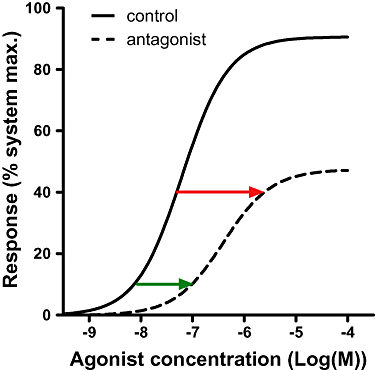Elusive equilibrium: the challenge of interpreting receptor pharmacology using calcium assays
- PMID: 20977466
- PMCID: PMC3000651
- DOI: 10.1111/j.1476-5381.2010.00863.x
Elusive equilibrium: the challenge of interpreting receptor pharmacology using calcium assays
Abstract
Calcium is a key intracellular signal that controls manifold cellular processes over a wide temporal range. The development of calcium-sensitive fluorescent dyes and proteins revolutionized our ability to visualize this important second messenger and its complex signalling characteristics. The subsequent advent of high throughput plate-based fluorescence readers has resulted in the calcium assay becoming the most widely utilized assay system for the characterization of novel receptor ligands. In this review we discuss common approaches to calcium assays, paying particular attention to the potential issues associated with interpretation of receptor pharmacology using this system. Topics covered include dye saturation and forced-coupling of receptors to the calcium pathway, but special consideration is given to the influence of non-equilibrium conditions in this rapid signalling system. Modelling the calcium transient in a kinetic mode allows the influence of ligand kinetics, receptor reserve and read time to be explored. This demonstrates that observed ligand pharmacology at very early time points can be quite different to that determined after longer incubations, even resulting in reversal of agonist potency orders that may be misinterpreted as agonist biased signalling. It also shows that estimates of antagonist affinity, whether by Schild analysis or inhibition curves, are similarly affected by hemi-equilibrium conditions. Finally we end with a discussion on practical approaches to accurately estimate the affinity of insurmountable antagonists using calcium assays.
Linked articles: This article is part of a themed section on Analytical Receptor Pharmacology in Drug Discovery. To view the other articles in this section visit http://dx.doi.org/10.1111/bph.2010.161.issue-6.
© 2010 The Authors. British Journal of Pharmacology © 2010 The British Pharmacological Society.
Figures









Similar articles
-
Use of the GTPγS ([35S]GTPγS and Eu-GTPγS) binding assay for analysis of ligand potency and efficacy at G protein-coupled receptors.Br J Pharmacol. 2010 Nov;161(6):1238-49. doi: 10.1111/j.1476-5381.2010.00963.x. Br J Pharmacol. 2010. PMID: 20662841 Free PMC article. Review.
-
Estimation of the dissociation rate of unlabelled ligand-receptor complexes by a 'two-step' competition binding approach.Br J Pharmacol. 2010 Nov;161(6):1311-28. doi: 10.1111/j.1476-5381.2010.00931.x. Br J Pharmacol. 2010. PMID: 20946109 Free PMC article.
-
Matching models to data: a receptor pharmacologist's guide.Br J Pharmacol. 2010 Nov;161(6):1276-90. doi: 10.1111/j.1476-5381.2010.00879.x. Br J Pharmacol. 2010. PMID: 20977467 Free PMC article. Review.
-
Fluorescence- and bioluminescence-based approaches to study GPCR ligand binding.Br J Pharmacol. 2016 Oct;173(20):3028-37. doi: 10.1111/bph.13316. Epub 2015 Nov 5. Br J Pharmacol. 2016. PMID: 26317175 Free PMC article. Review.
-
Ligand binding assays at equilibrium: validation and interpretation.Br J Pharmacol. 2010 Nov;161(6):1219-37. doi: 10.1111/j.1476-5381.2009.00604.x. Br J Pharmacol. 2010. PMID: 20132208 Free PMC article. Review.
Cited by
-
Clozapine, atypical antipsychotics, and the benefits of fast-off D2 dopamine receptor antagonism.Naunyn Schmiedebergs Arch Pharmacol. 2012 Apr;385(4):337-72. doi: 10.1007/s00210-012-0734-2. Epub 2012 Feb 14. Naunyn Schmiedebergs Arch Pharmacol. 2012. PMID: 22331262 Review.
-
The Target Residence Time of Antihistamines Determines Their Antagonism of the G Protein-Coupled Histamine H1 Receptor.Front Pharmacol. 2017 Sep 25;8:667. doi: 10.3389/fphar.2017.00667. eCollection 2017. Front Pharmacol. 2017. PMID: 29033838 Free PMC article.
-
Off-target activity of NBOMes and NBOMe analogs at the µ opioid receptor.Arch Toxicol. 2023 May;97(5):1367-1384. doi: 10.1007/s00204-023-03465-9. Epub 2023 Feb 28. Arch Toxicol. 2023. PMID: 36853332
-
Unique Pharmacological Properties of α-Conotoxin OmIA at α7 nAChRs.Front Pharmacol. 2021 Dec 8;12:803397. doi: 10.3389/fphar.2021.803397. eCollection 2021. Front Pharmacol. 2021. PMID: 34955864 Free PMC article.
-
In vitro CB1 receptor activity of halogenated indazole synthetic cannabinoid receptor agonists.Arch Toxicol. 2025 Aug;99(8):3343-3353. doi: 10.1007/s00204-025-04082-4. Epub 2025 May 18. Arch Toxicol. 2025. PMID: 40382747 Free PMC article.
References
-
- Ariens EJ. Affinity and intrinsic activity in theory of compepitive inhibition. Part I. Problems and theory. Arch Int Pharmacodyn. 1954;99:32–49. - PubMed
-
- Augustine GJ. How does calcium trigger neurotransmitter release? Curr Opin Neurobiol. 2001;11:320–326. - PubMed
-
- Berridge MJ. Calcium oscillations. J Biol Chem. 1990;265:9583–9586. - PubMed
Publication types
MeSH terms
Substances
LinkOut - more resources
Full Text Sources

